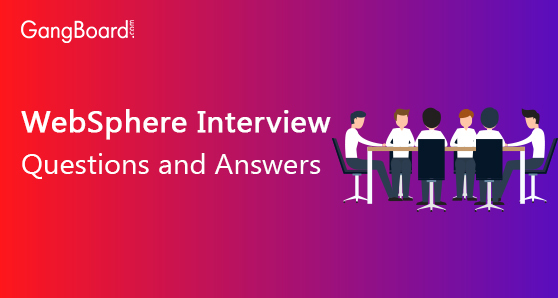
WebSphere Interview Questions and Answers
In case you’re searching for WebSphere Interview Questions and Answers for Experienced or Freshers, you are at the correct place. There is a parcel of chances from many presumed organizations on the planet.
The WebSphere advertise is relied upon to develop to more than $5 billion by 2021, from just $180 million, as per WebSphere industry gauges. In this way, despite everything you have the chance to push forward in your vocation in WebSphere Development. GangBoard offers Advanced WebSphere Interview Questions and answers that assist you in splitting your WebSphere interview and procure dream vocation as WebSphere Developer.
Best WebSphere Interview Questions and Answers
Do you believe that you have the right stuff to be a section in the advancement of future WebSphere, the GangBoard is here to control you to sustain your vocation. Various fortune 1000 organizations around the world are utilizing the innovation of WebSphere to meet the necessities of their customers. WebSphere is being utilized as a part of numerous businesses. To have a great development in WebSphere work, our page furnishes you with nitty-gritty data as
WebSphere prospective employee meeting questions and answers. WebSphere Interview Questions and answers are prepared by 10+ years experienced industry experts. WebSphere Interview Questions and answers are very useful to the Fresher or Experienced person who is looking for the new challenging job from the reputed company. Our WebSphere Questions and answers are very simple and have more examples for your better understanding.
By this WebSphere Interview Questions and answers, many students are got placed in many reputed companies with high package salary. So utilize our WebSphere Interview Questions and answers to grow in your career.
Q1) What do you understand by Ripplestart?
Answer: This is needed to restart the WAS cluster. It does so by first stopping the JVM and then kickstarting it again.
Q2) What do you understand by nose sync?
Answer: The entire configuration in the central repository in the IBM WAS stored is called Master Repository. The one-way communication that happens from the master to local repository is known as Sync.
Q3) If the DMGR is down could the applications run without any issues?
Answer: Yes, even if the DMGR is down the applications can run without any problems. However, if any changes or modifications need to be executed via the DMGR then there could be a potential problem involved.
Q4) State the three ways to deploy an application in WebSphere.
Answer: The three ways to deploy an application in WebSphere are as follows… scripts, DMGR and Hot deployment.
Q5) State the kinds of files which can be deployed into WebSphere.
Answer: The following are the types of files that could be deployed in WebSphere…WAR, JAR, EAR, SAR module.
Q6) What do you understand by a virtual host?
Answer: When multiple URLs are contained it is known as a virtual host. This can be either IP or FQDN based on a single application.
Q7) State the default WAS port.
Answer: For HTTP it is 9080 and for HTTPS it is 9443.
Q8) State the available WebSphere editions.
Answer: The available WebSphere editions that are available are as follows… WAS – Network Deployment, WAS – Developers, WAS – z/OS, WAS – Hypervisor, WAS – Express, WAS – Base and WAS – Liberty core.
Q9) What are the usual issues that a user would potentially experience?
Answer: Some of the common issues which any user would potentially experience are as follows… virtual host not defined, logs not moving, internal server error, out of memory exception, slowness, JVM not starting up, High CPU/ memory and disk utilization.
Q10) State the difference between a vertical and horizontal cluster.
Answer: A horizontal cluster is across multiple nodes and serves in a cell and a vertical cluster has its members on the same server or node.
Q11) What do you understand by garbage collection?
Answer: A memory management system that automatically frees up the objects which are currently not being utilized in the program, is known as Garbage Collection.
Q12) How does one make WebSphere autostart when the server is rebooted?
Answer: If the WebSphere needs to be restarted all over, it automatically generates its own startup script which ensures a boost in its programming systems.
Q13) When the node agent is down could the node be synced at that time?
Answer: In order for the sync to function the node agent must be stopped.
Q14) What do you understand by node federation?
Answer: When a node is added to the Cell, it is known as the Federation in WebSphere. Depending on the node sizes, it take a varying amount of time.
Q15) What is the full form of FFDC?
Answer: The full form of FFDC is the first failure data capture.
Q16) Which is the default language for scripting in WebSphere?
Answer: The default language for scripting in WebSphere is JACL
Q17) In a single JVM is it possible to deploy more than one application?
Answer: Yes in a single JVM it is possible to deploy several applications deployment. The only condition is that the context root for each respective application must be unique.
Q18) With WebSphere which are the various databases that can be supported?
Answer: Along with WebSphere the other databases that can be supported are as follows… DB2, Oracle Database, Microsoft SQL Server and Sybase
Q19) Which are the two ways to connect the webserver to WAS?
Answer: The two ways to connect are as follows… using proxypass and using the plugin.
Q20) In front of WAS is there a web server needed?
Answer: Yes a web server is required for increased maintenance, security, and performance.
Q21) Describe a cell.
Answer: A logical and rational collection of nodes is known as a cell. A cell can encompass more than one node, cluster and are controlled from a singular administrative console.
Q22) Describe a fix pack.
Answer: A collection of patches given by IBM is known as a fix pack. It may potentially encompass security patches, but fixes and performance improvements.
Q23) State the entire registry supported in WebSphere.
Answer: The registry in the WebSphere reads as follows… Federated repository, Standalone custom registry, Local Operating System and Standalone LDAP registry.
Q24) What do you understand by shared libraries?
Answer: In order to decrease duplicate library files, shared libraries are created.
Q25) Is it possible to change the context root for the deployed application?
Answer: Yes, it is possible to do so, however, JVM needs to be restarted after the change.
Q26) What is the full form of PMT?
Answer: The full form of PMT is a profiled management tool.


 +1 201-949-7520
+1 201-949-7520 +91-9707 240 250
+91-9707 240 250